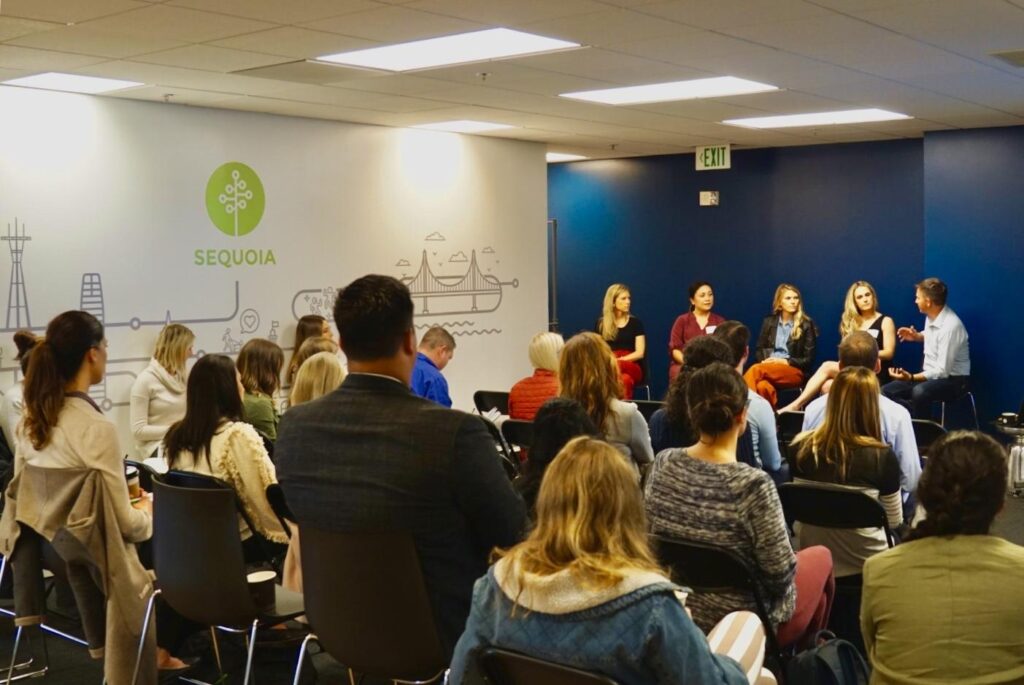How to setup your program and gain quick wins
I recently moderated a fascinating conversation at Sequoia’s office on Employee Wellbeing where we explored how to setup a program and gain quick wins. I am continuously amazed at how much this area and the supporting industry has recently evolved. About a dozen years ago when I was consulting in-house at tech companies and helping them hire new employees, we always framed “wellbeing” as a perk next to free lunches and maybe taking an afternoon off for a Giants game. These were seen as great recruiting tools but I can’t recall ever any discussion where we thought of them as helping with an employee’s emotional, physical, or financial health. Today, with the ongoing transformation from HR Directors being called and thought of as Head of People or Head of Employee Culture, Wellbeing has shifted to where it always should have been, to the care of a company’s people.
I was joined by Kaleana Markley, Sequoia’s Director of Wellbeing, as she is both responsible for Sequoia’s own company program but also leads the firm’s consulting practice. Aylson Friedensohn, the Co-founder and CEO of Modern Health, a company that has built an entire platform focused on helping employees with their emotional health. Michelle Saba joined us from LendUp where she works to their People Operations team and has built their current Employee Wellbeing Program. Finally we also joined by Lindsay Bailey, the Founder and CEO of FitPros, a team of fitness professionals that bring physical wellbeing classes to your workplace. In addition to these experts, the appeal of these monthly HR Thought Leadership Sessions are the 30+ awesome HR, Finance, and Ops Leaders that also join in the conversation and contribute their wisdom to the dialogue.
So what are my take-aways?
How does a company get a quick win? I learned that the most obvious and quickest way forward is to examine what is already available to you. Kaleana pointed out that there are frequently “hidden benefits” that can be utilized through your current insurance carriers such as health coaching, telemedicine, 24-hour nurse lines, seminars, and even employee assistance programs. With a few hours of research, you can dive deep into what your existing vendors offer and put together a solid program. Additionally, take a look at what you’re spending money on and see if it’s being used and whether it should be reallocated to other programs that might be embraced. Ultimately, the program should be built for what employees want and will utilize so if you have passionate employees that want onsite yoga for example, and someone on your team is a yoga instructor, leverage the opportunity to have them teach a class onsite.
Once you have a program in place that meets your team’s needs, it’s important that it be used. Whereas with traditional employee perks that when unused saves the company money, Wellbeing programs need to be, within reason, strongly encouraged because the purpose of the program is to allow the employee to reduce themselves of stress, improve their emotional and physical health, and ultimately become happier people. Since Michelle has been responsible for both building and maintain LendUp’s program, she encouraged hosting internal events like a “Wellness Week” where vendor partners can come to the workplace and employees can try out new programs. She also strongly recommended that each location identify a “Wellness Champion” that can lead the process, encourage their colleagues to participate, and work with managers to make certain that everyone knows that working 24/7 is not only discouraged but bad for company business.
Lindsay Bailey, the CEO of FitPros, shared with the room her personal journey from being an overworked and largely unhappy employee to focusing her efforts on becoming a health coach and starting her company. She recommended, which is a theme that I heard at several points during the session, that companies need to focus on surveying their employees to find out what is needed and how to best support them. There has been a shift within organizations, particularly in the Bay Area, where people live to work and many have a large commute. It’s hard to separate personal time from work time so things overlap and blur until it’s hard to distinguish when someone is working and when someone is on their own time but still checking emails or thinking about work issues.
This is where addressing emotional health is so important said Alyson Friedensohn of Modern Health. We all want to be happier and to arrive there, we need to dig into what is causing stress in our life because it can be very complex. In many ways, it’s simply hard to quantify according to Kaleana so smart companies are starting to focus on non-traditional metrics like the Value of Investment (VOI) vs. the usual Return of Investment (ROI) metrics. While it’s hard to establish baselines, we all need determine what are our business goals as they relate to Wellbeing.
As I reflect on the conversation, there were a number of large and smaller insights shared by both the panel and the experienced audience in attendance. If I were building a new Wellbeing Program, I suggest the following steps:
- Survey your employees and learn what they need.
- Explore what programs and services that you already can access to with minimal costs.
- Build a process for better engaging your employees in programs, such as hosting Wellbeing Events, and ideally involve employees in the process itself.
- Be creative and focus on non-traditional metrics like happiness and employee retention.
Good luck and be well!



